Best Waterfall Hikes in Yosemite
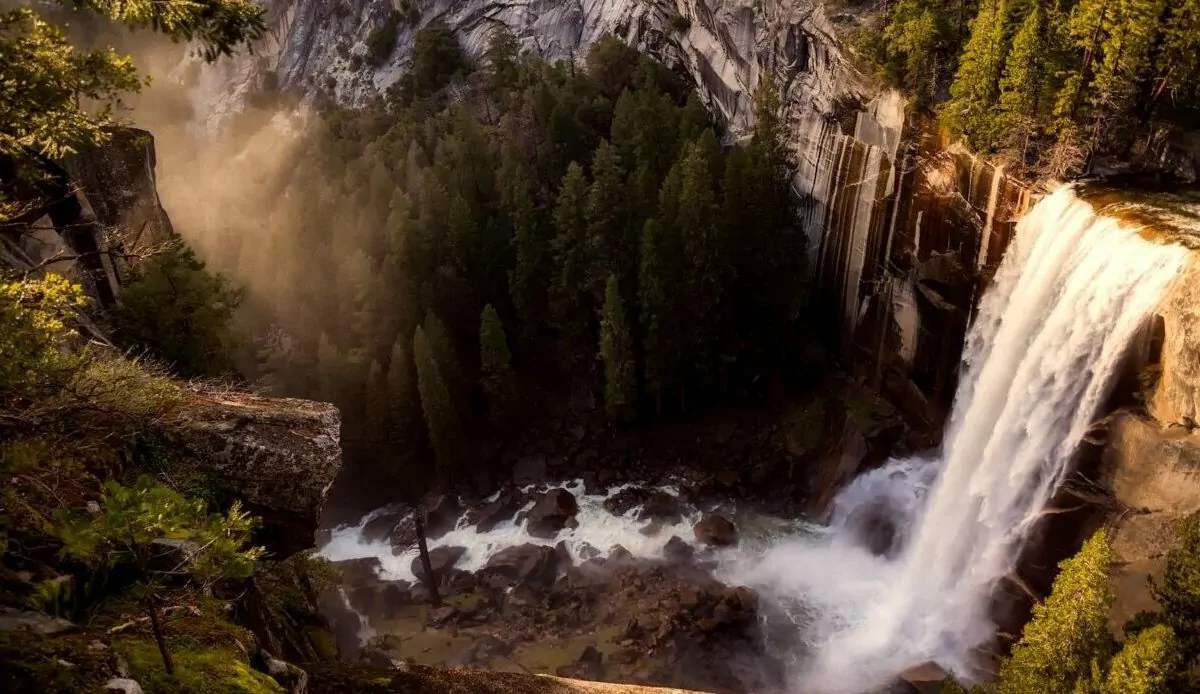
Yosemite National Park in California is perhaps the crown jewel of the United States’ Park system. Over millions of years, granite rose from underground to reveal itself as the Sierra Nevada range. A shift in plate tectonics caused a great tilt, changing what were once meandering streams into fast-flowing rivers. Glaciers moved through Yosemite Valley, carving and defining the iconic mountainscape we know today. These mighty forces are why Yosemite is home to so many waterfalls: majestic cascades of water falling high from granite peaks.
Award Winning Yosemite Hiking Adventures
With so many wonderful waterfall hikes in Yosemite, it is difficult to know where to begin. Use this guide on your next trip to discover the best waterfall hikes in Yosemite! You will find a description of each waterfall hike including trip notes, how to get there, when to go, what the crowds are like, and what you should bring with you.
| Trip | Difficulty | Miles Roundtrip | Elevation Change
|
| Vernal and Nevada Falls | Strenuous | 5.4 (or 6.5) | 2,192′ |
| Yosemite Falls | Strenuous | 5.0 | 3,179′ |
| Glen Aulin | Moderate | 11.0 | 1,100′ |
| Wapama Falls | Easy | 5.0 | 954′ |
| Chilnualna Falls | Moderate-Strenuous | 7.9 | 2,188′ |
1. Vernal and Nevada Falls
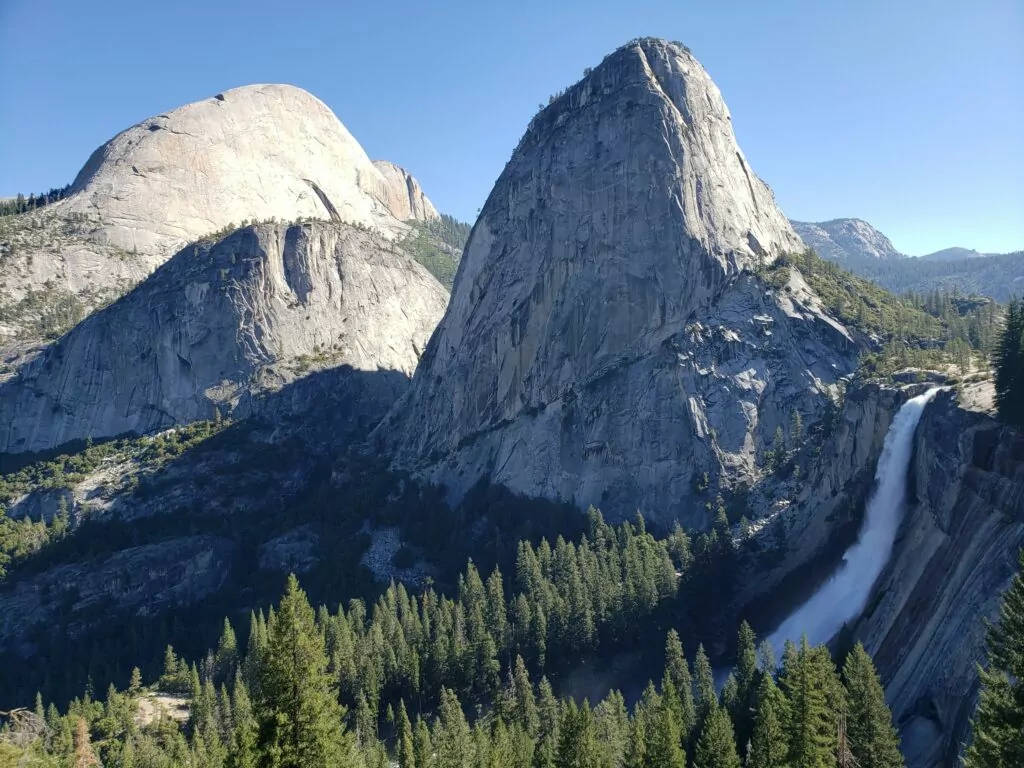
The Waterfall
Vernal Falls
Who doesn’t love a two for one!? The first of two magnificent waterfalls visited on this hike is Vernal Falls. Before witnessing the full spectacle of the Fall, the footbridge crossing of the Merced River allows hikers to appreciate the power that Vernal generates just a few hundred feet upriver. However, there is hardly a shortage of appreciation when one approaches Vernal Falls. After a drop of 317 feet, instead of resting, the water suspends in a mist across the trail below! A sloping wedge of granite sticks out at the base of the fall, causing the water to spray out instead of dive straight back into the Merced River. This vapor hanging in the air creates floating rainbows, the consistent companions of Vernal Fall.
Nevada Fall
Nevada Fall sits at 5,971 feet in elevation and plunges straight down an impressive 594 feet drop. There are several excellent viewing areas, including a railed ledge hanging right next to the big plunge! The same water then meanders down to feed Vernal Falls. The upper Montane summit of Nevada Fall is truly breathtaking, dominated by granite slick rock and massive Jeffery Pines. Oh, and hikers get absolutely spectacular views towards the valley from the trail.
Trip Description
Two waterfalls, two famous trails, and incredible vistas—there’s a reason why this is the most popular day hike in all of Yosemite! The hike comes to 5.4 miles as an out-and-back on the Mist Trail,. Or, as I much prefer, you can make a 6.5 loop by going up the Mist Trail and connecting to the John Muir Trail to return to the trailhead. The loop is a bit longer, but the descent is much more gradual, and you avoid down-climbing the Mist Trail’s slippery rocks.
Mist Trail
At the Happy Isles shuttle stop, go over the bridge and take the first right onto the Mist Trail. The first section of the trail is definitely the busiest and quickly becomes quite steep as it follows the Merced River. During spring, you may be able to catch a glimpse of Illillouette Falls off in the distance to the right. After one mile, a footbridge over the Merced provides the first view of lower Vernal Falls upriver.
Shortly after, the Mist Trail reveals its namesake. This mystical section of the trail is very fun and refreshing on a hot day. Have a rain jacket ready and store any valuables in a waterproof bag, because you will definitely be getting wet!
The top of Vernal Falls has an excellent view, and even railings so you can get up close and personal. The trail continues upriver past the Silver Apron, a granite shoot resembling a waterslide, and Emerald pool, so named for the beautiful color and seemingly tranquil water. However, the undercurrent is deceptively strong and swimming is strictly prohibited. Nearby is a set of toilets and another footbridge crossing back over the Merced, providing another nice vantage point of this mighty section of the river.
Nevada Fall
The trail then winds delightfully through shaded forest, where massive incense cedars, ponderosa pines, and Jeffery pines stand. Through the trees, an open area provides views of the base of Nevada Fall. Check this out before continuing up the next steep section of the trail. Soon, you will be walking over an expanse of spiraling white and grey granite that leads to the top of Nevada Fall. From here, you can see the waterfall nearly 600 feet down to its base. You can see Liberty Cap, Mount Broderick, Grizzly Peak, and maybe even a sliver of Half Dome. This is the ultimate lunch spot, so make sure to pack a picnic!
John Muir Trail
Once you’re fed and rested, it is time to start the descent. Here is where you make your choice: either go back down the way you came or make it a loop. If you decide to do the loop, follow the trail over the river and keep going straight and then down on the historic John Muir Trail (JMT). This section of trail is actually the beginning (or end) of a 321-mile trail named after the legendary naturalist who played a vital role in creating the Yosemite that we know today.
The JMT immediately shows off some stunning rock-work as you cross under a seasonal mini-waterfall. Once around the bend, look back for the best photo opportunity of Nevada Fall in all her glory! From here, the well-maintained trail is equipped with gradual switchbacks all the way back to the Mist Trail near the Vernal Falls footbridge.
Best Season
Peak snowmelt is generally between April and June. At this time of year, the waterfall will the strongest. If possible, shoot for April when summer crowds have not quite hit (outside of Spring Break week). Summer visitors will enjoy cooling down in the mist, just try to hike it as early as possible to beat the crowds.
Crowds
As previously mentioned, this is the most popular day hike in Yosemite National Park. In peak season, this is an incredibly crowded trail. Hiking early in the morning, on weekdays, and outside of peak season will help.
How to Get There
From Curry Village, walk or ride the free shuttle bus to the Happy Isles bus stop (stop number 16). If walking, you will turn right out of Curry Village and walk over the bridge. Turn right onto the Mist Trail which runs parallel to the Merced River.
If driving, follow signs from whichever entrance you have arrived towards Yosemite Valley or Curry Village. The most convenient parking is at Curry Village. Other options are to find parking on the road opposite Curry Village or try to snag a spot in one of the daily use parking areas.
Hydration and Hygiene
This hike will take the average hiker several hours to complete, so make sure to bring adequate food and water. In summer, each person should drink 3-4 liters of water per hike. Potable water is found at the Happy Isles bus stop and at a water fountain just over the Vernal Falls footbridge, approximately one mile into the hike. A few ephemeral streams along the way can be used with a water purifying system, depending on the season.
There are toilets just past Emerald Pool (signed) and one at the top of the Mist Trail, just before turning towards Nevada Falls. Unfortunately, the toilet block at the Vernal Falls footbridge (at the time of this article) has been closed for several years, so do not rely on it.
Be familiar with Leave No Trace techniques for toileting in the backcountry and make sure to ALWAYS pack out all of your trash, including your toilet paper!
What to Pack
When granite is wet, it gets very slippery. When granite is dry and collects trail dust, it gets very slippery. Hiking around the granite of the Sierra Nevada necessitates shoes with good tread to keep your footing sure. Depending on your level of comfort, this trail can be hiked in boots, hiking shoes, trail runners, or even hiking sandals.
Trekking poles are very handy on this hike. They will help you keep your footing while climbing up the rocks and relieve some knee pressure on the way down.
Bring plenty of snacks, water, and lunch for a picnic at the top.
Always bring raingear on a hike in the mountains, but in this case, you really need it. Have a waterproof bag or even just a ziplock to keep your valuables dry.
Hike Vernal and Nevada Falls with a Guide
Guided Vernal and Nevada Falls day hikes are available and are a stress-free, exciting way to do this trip. The tour company handles permits, gear, transportation, meals, and provides a professional guide so you can focus 100% on enjoying your adventure. Read more…
Explore Your World. Award Winning Hiking Guides
2. Yosemite Falls
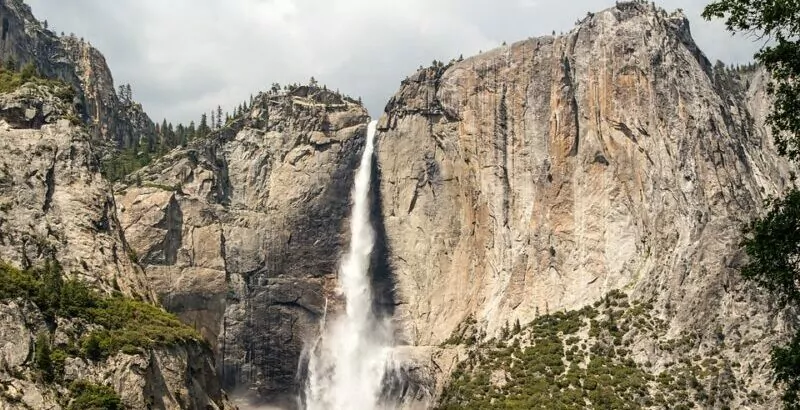
The Waterfall
In terms of grandeur and spectacle, Yosemite Falls is the star of this list. The largest waterfall in the entire park, it is three-tiered with a mind-boggling total fall of 2,425 feet. While the hike described here is “the” Yosemite Falls hike and should not be missed on your valley trip, it should be noted that this hike is more about the view of the valley (which is amazing!) than of the fall itself. Once at the top, the plunge is difficult to see and there are only a few points along the trail where you can actually see the water.
The best view of the falls on the entire hike is midway up the ascent at the base of the upper falls. The lower fall can be viewed with just a short walk from the Lower Yosemite Fall Bus Stop (Stop #6). Other great viewing sites of the upper and middle falls are from Swinging Bridge and from the meadows on the south side of the valley loop road (you can pull over in the designated parking lanes, though these fill quickly in peak season. Never park on the road in undesignated spots).
Trip Description
Upper Yosemite Falls
The trail begins in rock climbing mecca Camp Four and wanders by a few of the campground’s famous boulders (most likely sprinkled with some climbers). The big ascent starts with a lovely oak and pine-shaded section of switchbacks. The shade doesn’t last forever though, so be prepared with adequate sun protection. In this lower exposed section, swaths of red-trunked manzanita and colorful sierra paintbrush line the trail. The viewpoint at Columbia Rock offers stunning views of the valley floor, Half Dome, and Sentinel Rock.
Shortly after Columbia Rock, you can take a small social trail on the right-hand side that leads down to a viewing area with a guard rail. This is the first (and best) glimpse of Yosemite Falls! Continue on the main trail to the base of the upper falls, and enjoy the mist and the thunder of the water below. This is approximately halfway up the climb.
From here, the trail leaves the shade, exposing hikers to quite a lot of sun and heat in the summer. The switchbacks also get steep near the end. Finally, all the hard work pays off as you cross over a small creek and then step up to the top of the Yosemite Falls trail! The summit’s steep sides and big boulders prevent a direct view of the top of the fall from here, but the slick rock lunch spot with sprawling views of the valley floor below can hardly be beaten!
When it’s time to return to the trailhead, simply turn around and follow the same trail back down. Be mindful of footing on the way down, there are many slippery areas that are not helped by tired legs.
Viewpoint Possibilities
For the more adventurous, check out the trail that leads down the other side of the granite right next to the fall. This section is great for a close-up of Yosemite Falls but is definitely not for those with a fear of heights. There is some pretty serious exposure to get down to the viewing ledge, which is mostly—but not entirely—railed. Use extreme caution and enjoy an exhilarating view!
If you still haven’t had enough climbing, there is another great point of interest possible on this day hike. Follow the main trail towards North Dome, crossing the footbridge over Yosemite Creek. This trail leads up to Yosemite Point for yet another, higher, panorama of the valley floor. This is definitely one of the best views in the park. It is an extra 1.6-mile roundtrip detour from the footbridge and back, but well worth the effort.
Season
The best season to hike the Yosemite Falls Trail is spring when the water is highest, and the summer crowds and heat have not yet arrived. In summer, this hike is crowded and very hot. In winter, icy conditions make the trail very dangerous. Use extreme caution in cold weather, as ice will form at higher elevations even when it is not present in the valley.
Crowds
This is a very popular hike most of the year and peak-season crowding is extreme. Start as early as possible to avoid the bulk of the crowd on the way up.
How to Get There
If taking the shuttle, get off at Camp Four Shuttle Stop #7. If driving, the closest parking is also at Shuttle Stop #7 in the Yosemite Lodge parking lot on the left-hand side of the road. Be sure to arrive very early as the spots will fill quickly. You cannot park in the Camp Four parking lot (right side of the road) unless you are camping there.
Once parked or off the shuttle, take the main path straight through Camp Four towards the North Rim. At the base of the climb, you will see a sign to Yosemite Falls in front of shady switchbacks.
Hydration and Hygiene
Potable water and toilets can be found in the parking lot across from Camp Four. There is not a spot to refill along the trail unless you have a water filtration method, such as a Sawyer Squeeze or Aqua Mira droplets. The small creek at the top of the climb is reliable and, depending on the season, you may find small springs and ephemeral streams along the way.
There are not any toileting facilities along the trail.
What to Pack
There are many sections of slippery rocks and lots of elevation change on this hike. Broken in hiking boots with ankle support and good tread will be your friend. Those with strong ankles not prone to rolling will get by just fine with hiking shoes.
Hiking poles are recommended, particularly for the steep downhill portions.
Carry more water than you think you’ll need. This is an exhausting hike and unless you can purify, there are no potable water once you get going. Snacks will fuel you up the climb, and a packed lunch for the summit will motivate you for the long descent.
Hike Upper Yosemite Falls with a Guide
Guided Upper Yosemite Falls day hikes are available and are a stress-free, exciting way to do this trip. The tour company handles permits, gear, transportation, meals, and provides a professional guide so you can focus 100% on enjoying your adventure.
3. Glen Aulin
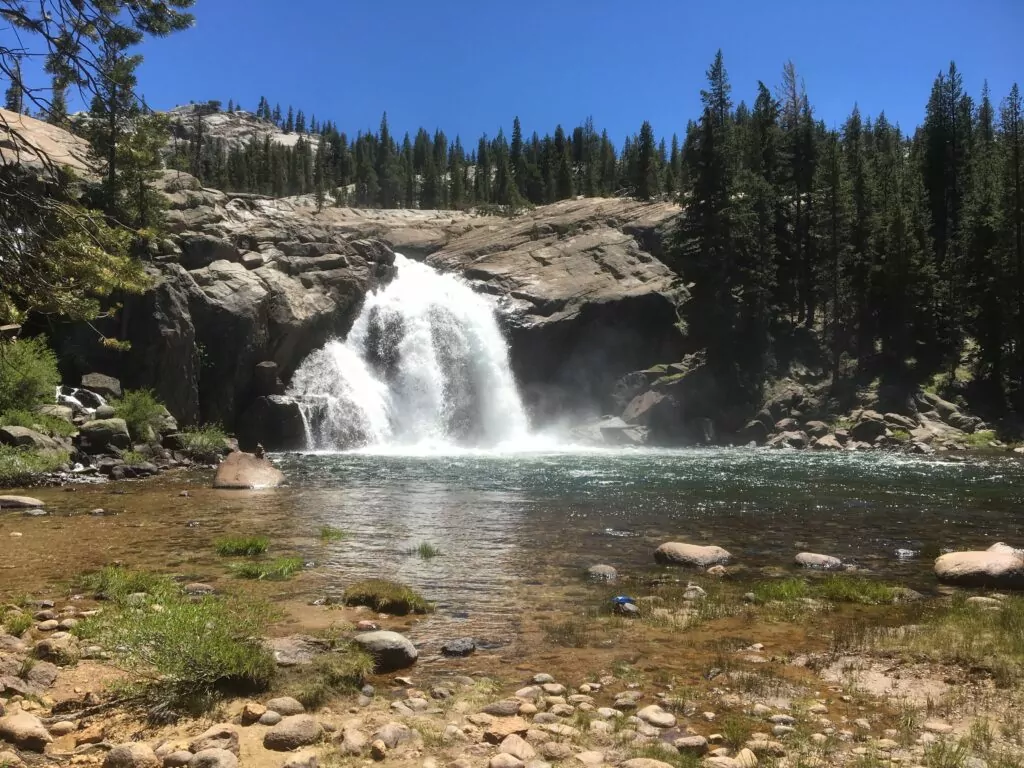
The Waterfall
Let’s start this one by noting that Glen Aulin is not actually a waterfall. Rather, it is a segment of the Tuolumne River valley nestled in the midst of Yosemite’s breathtakingly beautiful high country. Home to the fabulous High Sierra Camp of the same name (Yosemite has eight High Sierra Camps in total), the gorgeous meadows of Glen Aulin are relatively close to the “civilization” of Tuolumne Meadows but they feel like another world. The hike to Glen Aulin features two waterfalls and is a favorite of both guests to the park and local residents.
First up is Tuolumne Falls, with a very photogenic vertical drop of nearly 50 feet. The day’s turn-around point is at White Cascade, also plummeting about 50 feet, into a gorgeous swimming hole. Wade into the pool from the sandy beach or jump from one of the rocks on either side of the waterfall. If the fall is calm enough and you can stand the very cold water (snowmelt!) for long enough, you can swim behind the fall. Here, a small nook offers a few moments of utter magic. If cold water isn’t your thing, rest your legs in the sand and relax in one of the most picturesque places in Yosemite.
Trip Description
Yosemite High Country
This hike is the only one on the list located in the “high country” of Yosemite National Park, so-called because of its high elevation compared to the valley. Coming in at 11 miles roundtrip, this trail is best done as an overnight or—for experienced hikers—as a long day hike.
Before even setting foot on the trail, hikers are immersed in the spectacular scenery of Tuolumne Meadows. Gorgeous, sprawling meadows, cut by the Tuolumne River, are surrounded by snow-capped mountains on all sides. Visit historic Parsons Lodge and wonder at nature’s carbonation from Soda Spring just before hitting the trail. The Glen Aulin trail winds its way back into a forest filled with giant ponderosa and lodgepole pines. In the spring and early summer, wildflowers such as columbines, lupine, and alpine gold sprinkle the landscape with pops of color.
Glen Aulin Trail
Hike past the right turn-off to the stables. Shortly after, the trail crosses Delaney Creek, a wide but typically shallow crossing. Waterproof boots should make it across, no problem. If the water is too high, or you prefer to keep your shoes dry, there is a downed tree across the water a bit further upstream. This “bridge” is quite high and a fall could result in injury. Only attempt to cross it if you are sure-footed and confident. Dry shoes are not worth the cost of a broken bone!
Continue down the trail for half a mile and turn left at the T-intersection with a sign pointing to Glen Aulin, turning away from Young Lakes. So far, the trail has been mostly flat, tending down. Passing in and out of the forest, you’ll see large expanses of granite slick rock following the Tuolumne River and it’s famous “waterslide-esque” shoots.
About a mile after the Young Lakes turnoff, the big drop in elevation starts as you head down to Glen Aulin. You will pop out near the top of the waterfall before descending down to the base. Two footbridges lead you over the river and straight into Glen Aulin camp.
Camping at Glen Aulin
Large canvas cabin tents are available to rent for those who want a more glamping experience; however you need to enter a lottery to win a reservation, so make sure to plan and apply well in advance. There is also a backpackers camp where you can pitch a tent, but make sure you reserve the proper wilderness permit if you are planning on spending the night. You can start applying for your permit 24 weeks ahead of time. Glen Aulin is a popular destination, so if you are planning on visiting during summer or on a weekend, make sure to apply as soon as possible. If you aren’t able to snag a reservation, a limited number of walk-up permits are available at the wilderness permit office and can be applied for the morning prior to your hike’s start date.
Season
Early summer and early fall are the best seasons to visit Glen Aulin. Tioga Pass, the road through the high country, is closed in the winter and only opens once the snow has melted and maintenance is complete. This is usually late spring to early summer, but the road has opened as late as July 1st.
Later in the summer (usually July through August), Yosemite’s annual mosquito fest begins. This undesirable season of excessive mosquitos, particularly in the high country, is thanks to warmer weather combined with stagnant water accumulated from snowmelt. By September and October, the mosquitos are gone, along with summer crowds and heat. Although a swim may not be quite as tempting in the cooler weather, this is a fantastic time to visit Glen Aulin!
Crowds
While this is a popular hike, crowds will be nothing like those at Vernal/Nevada or Yosemite Falls. Definitely expect to see other hikers on trail, but you do not hike in a line as you would in the valley. The trail to Glen Aulin overlaps with the famous 2,650 miles long Pacific Crest Trail, so make sure to cheer on any thru-hikers you see on their way to Canada!
How to get there
If you are driving, follow the valley road to Big Oak Flat Road/Highway 120; it will be on the right before exiting the park via the El Portal entrance on Highway 140. Turn right onto Tioga Road. Follow the scenic road all the way to Tuolumne Meadows. Parking can be found along Tioga Road near the general store, in the Lembert Dome parking lot, or along the side road connected to the Lembert Dome parking lot. Note that the Lembert Dome lot is day-use only.
If you don’t have a car, Yosemite Hospitality offers a paid hiker bus from Yosemite Valley to Tuolumne Meadows.
Once in Tuolumne Meadows, walk on the dirt road heading northwest from the Lembert Dome parking lot. Go straight through the open gate, following the sign that reads ‘Pacific Crest Trail.’ Take a right at the split, and walk straight up to the large sign for Glen Aulin across the dirt road, behind Soda Springs and Parson’s Lodge.
Hydration and Hygiene
Potable water can be found at the Tuolumne Meadows campground, at the general store, and at Glen Aulin camp. Along the trail, there is ample water for those who can purify. Be very cautious when collecting water from the Tuolumne River as granite can be very slick when wet.
There are toilets at the Tuolumne Meadows general store and at the Lembert Dome parking lot. There are also toilet facilities at Glen Aulin.
What to Pack
Bring your sturdy hiking boots/shoes and trekking poles.
Even if you could finish this hike quickly, there is no way you would want to. Bring plenty of snacks and lunch to enjoy a full day out in beautiful Glen Aulin.
The most important item to pack for this trip is your swim attire!
Hike Tuolumne Meadows with a Guide
Guided Tuolumne Meadows backpacking trips are available and are a stress-free, exciting way to do this trip. The tour company handles permits, gear, transportation, meals, and provides a professional guide so you can focus 100% on enjoying your adventure. Read more…
4. Wapama Falls
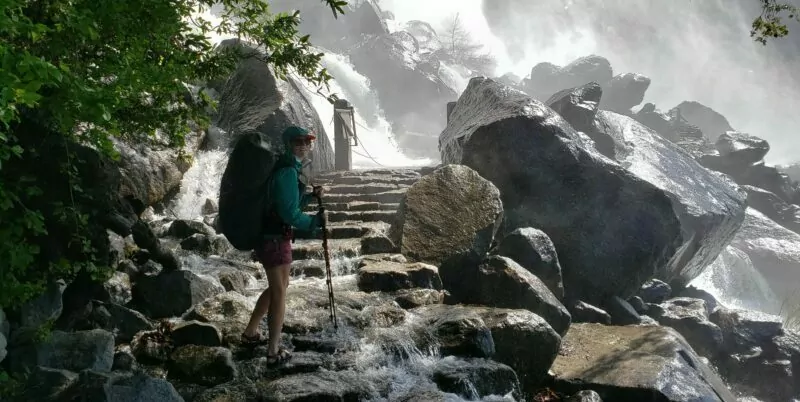
The Waterfall
Wapama Falls, located in stunning Hetch Hetchy, is a wide, three-tiered fall that drops 1,080 feet into the dammed lake below. The best view of the top and middle tiers is from across the reservoir, high on Kolana Rock. From the trail itself, only the lowest tier can be seen. This hike makes the list, however, due to the idyllic stroll along the water, followed by a climactic confrontation with the lowest drop! During peak snowmelt in spring, the fall thunders down and drenches hikers as they cross the footbridge at the base of the fall! In particularly wet years, the cascade can actually flood the bridge, making it impassible.
As a cherry on top, Wapama Falls sees only a small fraction of the visitors that its valley counterparts get. It is also the shortest hike on our list! Just shy of five miles roundtrip, this little jaunt out to Wapama Falls makes for a relaxing day hike, accessible to most hikers.
Trip Description
Hetch Hetchy Valley
The Tuolumne River running through the Hetch Hetchy Valley was dammed in 1923 to provide drinking water to the city of San Francisco. At one time Hetch Hetchy looked very much like a “smaller” Yosemite Valley. John Muir described the area as “one of nature’s rarest and more precious mountain temples.” While there is certainly an environmental ethics debate to be had, no one can deny that Hetch Hetchy, dammed or not, is one of Yosemite National Park’s most underappreciated gems. Granite peaks and domes command the upper landscape, while the eye follows the scattered cascades of Wapama Falls as they enter the sparkling reservoir.
Wapama Falls
The hike to Wapama Falls begins at the pedestrian bridge that crosses over the top of the O’Shaugnessy Dam. Interpretive signs along the bridge discuss the dam’s history and contain interesting facts about the river and surrounding area. A tunnel carved through the stone connects the bridge to the rest of the trail; be prepared to have wet feet if rain has fallen recently!
The trail continues along the northern bank of the reservoir until a trail intersection is reached. Turn right, continuing along the reservoir, towards Wapama Falls. This section of trail is great for wildflower viewing, and for admiring Koala Rock across the water. While the majority of the trail is mildly undulating, a few steep sections of climbing provide brief challenges, and a final rocky descent to the footbridge marks your arrival at Wapama Falls! In spring, be prepared with rain gear, or be ready for an icy shower!
If the hike to Wapama Falls is all you are after, continue back along the same trail to return to the trailhead. If you want a bigger day, Rancheria Falls is found about five miles farther along the same trail. Rancheria is a beautiful waterslide-style waterfall. This add-on brings the hike up to nearly 15 miles roundtrip with about 2,700 feet of elevation change. Much of the climb is quite exposed, making it a long, toasty one in the summer. It is possible to camp near Rancheria Falls with the proper wilderness permit.
Season
While it flows nearly year-round, the best time to visit Wapama Falls is during spring peak snowmelt. A bonus sighting of ribbon-like Tueeulala Falls might even be caught in the spring. Make sure to talk to a ranger at the entrance station about water levels if there has been a lot of snow that winter.
Crowds
This is a great hike for avoiding crowds. Only a fraction of park visitors makes their way to Hetch Hetchy, which is both a shame and a blessing. You will likely see others on the trail, but maybe only a few dozen tops (compare that to the hundreds on valley hikes!)
How to Get There
There is no public transportation option for traveling to Hetch Hetchy, so, unfortunately, you must have access to a car for this hike. It is 38 miles (1 hour and 20-minute drive) from Yosemite Valley.
From the valley, turn onto Highway 120 toward San Francisco. Continue on this beautiful stretch of scenic highway, passing the turnoff to Tioga Road on the right. After 18 miles, take a right on Evergreen Road. At the small township of Mather, the road will run into Hetch Hetchy Road. Turn right. This will take you straight through to the entrance gate.
If you are driving from Tuolumne Meadows, turn right onto Highway 120 and follow the instructions above.
As the road approaches the trailhead, it turns into a one-way loop. The first parking lot along the route is closest to the bathrooms. There is also day-use parking along the road next to O’Shaughnessy Dam.
Note: The Hetch Hetchy entrance gate does not open until 8:00 AM PST.
Hydration and Hygiene
There is no potable water at Hetch Hetchy. Bring all your drinking water with you. Due to the area’s (relatively) low elevation, it can be very hot in the summer. Plan on bringing extra water with you, at least 2 liters per person.
There are toilet blocks and trash cans at the first overnight parking area. Finding a spot to use the bathroom off-trail can be challenging. Make sure to use the facilities before you hike.
What to Pack
This trail is short and well-maintained. Comfortable shoes with good tread should be worn, but boots aren’t necessary. Trekking poles may be used but are not necessary, and could actually be a hindrance in the last rocky descent.
Although this hike is short, do not underestimate your need for fuel and hydration. Pack snacks and plenty water. There is lots of shade on the way to Wapama Falls. While you should still protect yourself, this trail offers much less sun-exposure than other hikes on this list.
5. Chilnualna Falls
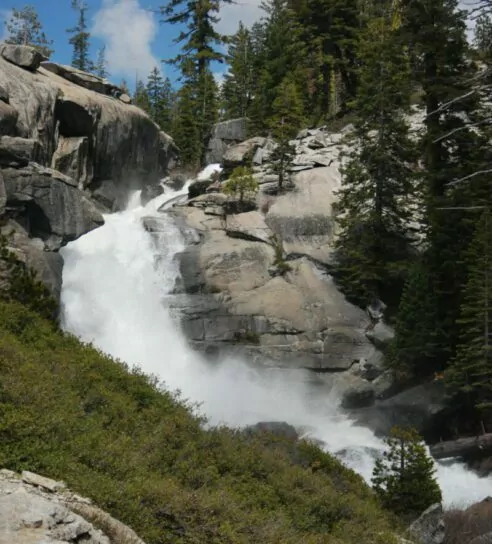
The Waterfall
Located in the quiet southern section of Yosemite National Park, Chilnualna Falls sees even fewer visitors than the aforementioned Wapama Falls. Even many Yosemite veterans have never been there! The falls are a series of cascades and pools with a total drop of 690 feet.
This may be the smallest fall on our list, sure, and perhaps not the most spectacular waterfall view, but it has some very stiff competitors. However, the gorgeous scenery, a few bonus cascades along the way, and the intimate experience that comes from a “unpopular” hike more than makes up for the lack in height. After all, haven’t we decided that it isn’t the size but the motion of the… waterfall… that’s important? Right?
Trip Description
This roundtrip, out-and-back hike to Chilnualna Falls is about 8 miles with a gain of 2,200 feet in elevation. There are some steep sections, but the very long continuous climb is what really makes it tough. Expect 4-6 hours of hiking.
The marked trailhead for Chilnualna Falls Trail is 100 meters east of the parking lot back up along the Chilnualna Falls Road. There is a fork at the trailhead. Take the right fork which is for hikers; the left is for horses. The forks will eventually join up again, but the hiker-only trail passes by a few beautiful bonus cascades.
The trail passes in and out of shady pine forests, following near Chilnualna Creek. Near the base of the fall, there is a side-path that leads down to the water where the lower fall can be viewed. After this, the trail leaves the creek and it isn’t seen again until the top of the falls. Because of this, there is not an ideal viewing area of the most dramatic upper fall. The best view comes about 0.25 miles before topping out, and it is a view from the side. From the top, it is too dangerous to get close enough to peer down the cascade. As they say, it is more about the journey than the photo.
Season
You probably see the pattern by now. Spring is the best time to visit for a fully-pumping waterfall!
Crowds
Crowds are very light. You could even be alone! There are about 20 parking spots at the trailhead, and it is very rare for them to be full.
How to Get There
If driving from the Valley, head on Highway 41 towards Wawona then drive east on Chilnualna Falls Road. You will pass the Redwoods in Yosemite Lodge. The parking area will be a slanted lot just off the side of the road. If you cross the bridge over Chilnualna Creek, you have gone too far.
There is not a public transportation option to get to this area, but you may be able to stick out your thumb for a ride from a new friend!
Hydration and Hygiene
There is not potable water at the trailhead. Plan to bring plenty of drinking water unless you have the ability to filter water once on the trail. On this long, challenging hike, it is very easy to drink 4 liters of water per person.
There are bathrooms at the trailhead, but none to be found along the trail itself.
What to Pack
Sturdy hiking shoes/boots with good tread. There are several areas with slippery rocks. Hiking poles are recommended for both the change in elevation and for aiding with the creek crossings along the way.
As this hike will likely take most of the day, bring plenty of food.
There are several trails that intersect the Chilnualna Falls Trail, which can make navigation a bit tricky. Have a reliable way to navigate. Ideally, you should carry an updated map and compass, and know how to use them. There are also several GPS hiking apps that are very useful, such as AllTrails. With a subscription, you can download an offline map and have your location updated with GPS even if you do not have reception.
Go out and enjoy the best waterfall hikes in Yosemite! If you need more inspiration for your next Yosemite adventure, check out our article on the Top Peak-Bagging Hikes in Yosemite. For anyone looking for a multi-day excursion, consider a guided Yosemite backpacking adventure.
Wildland Trekking Hiking Adventures
As the world’s premier hiking and trekking company, Wildland believes in connecting people to fantastic environments in amazing ways. Wildland Trekking Company offers an array of incredible hiking and trekking experiences in 9 states and 11 countries. Read more about our world-class destinations.
To learn more about our guided backpacking trips and all of our award-winning hiking vacations, please visit our website or connect with one of our Adventure Consultants: 800-715-HIKE.




